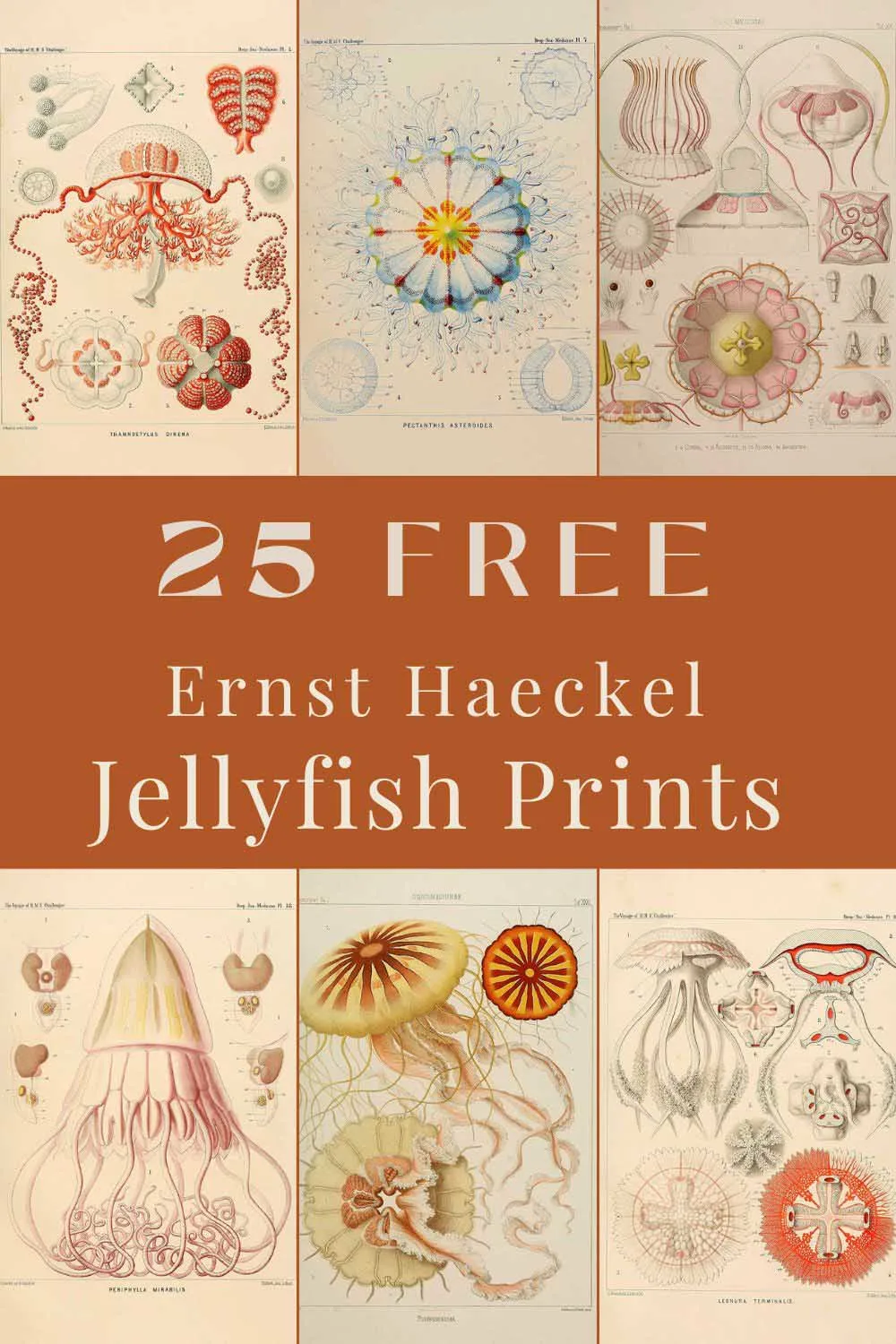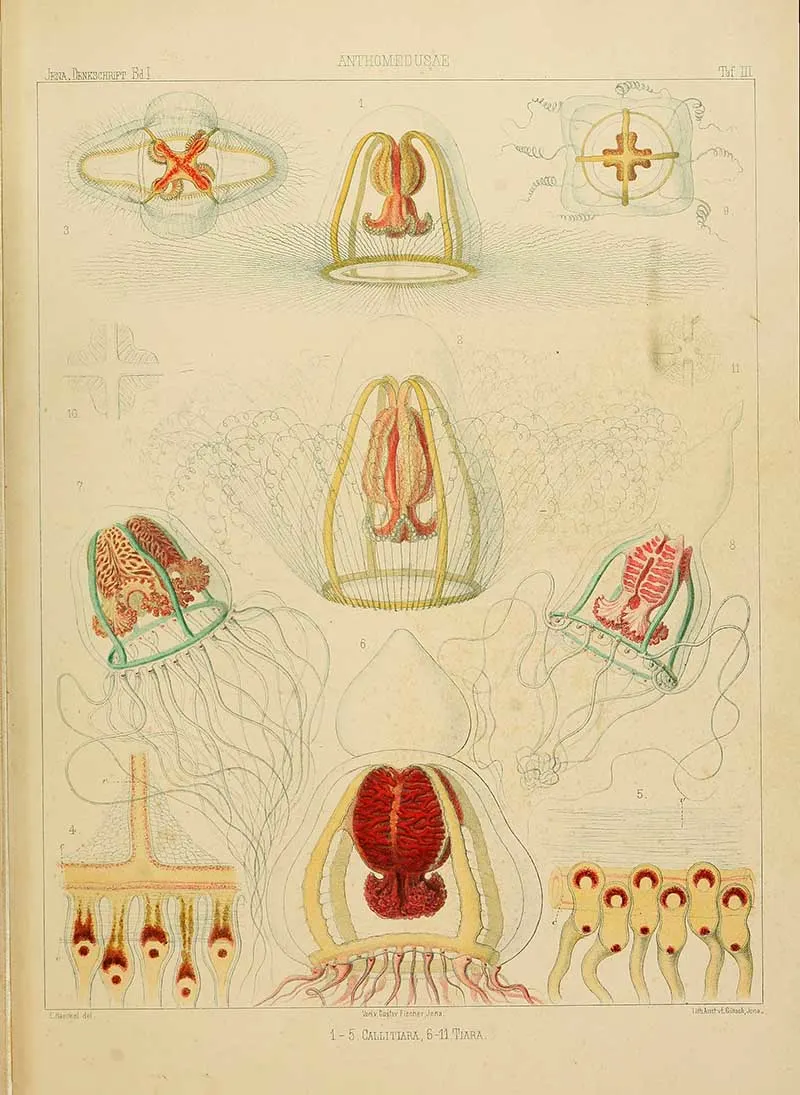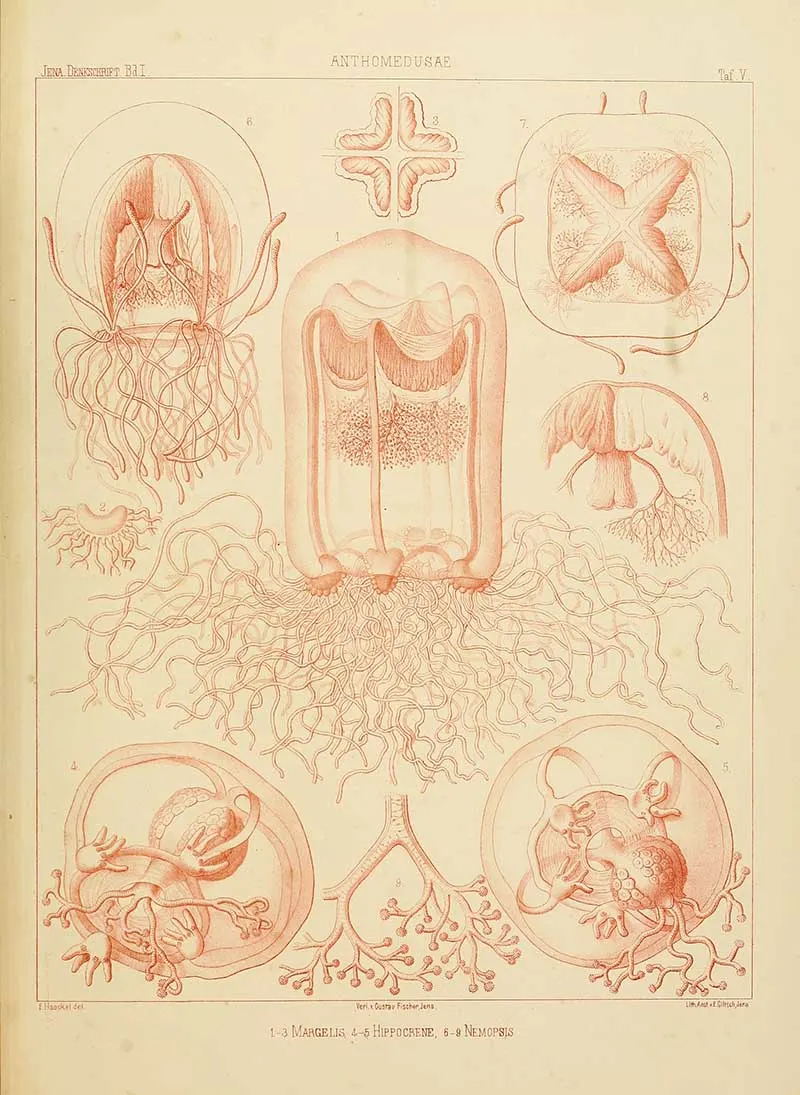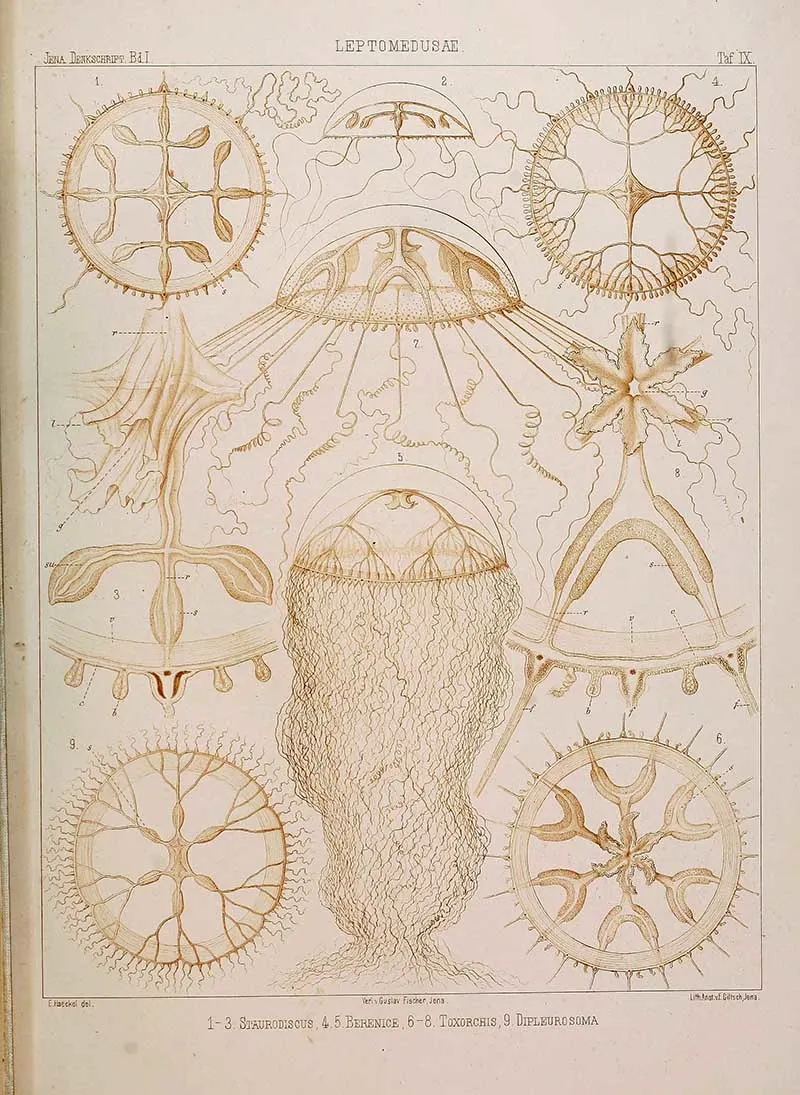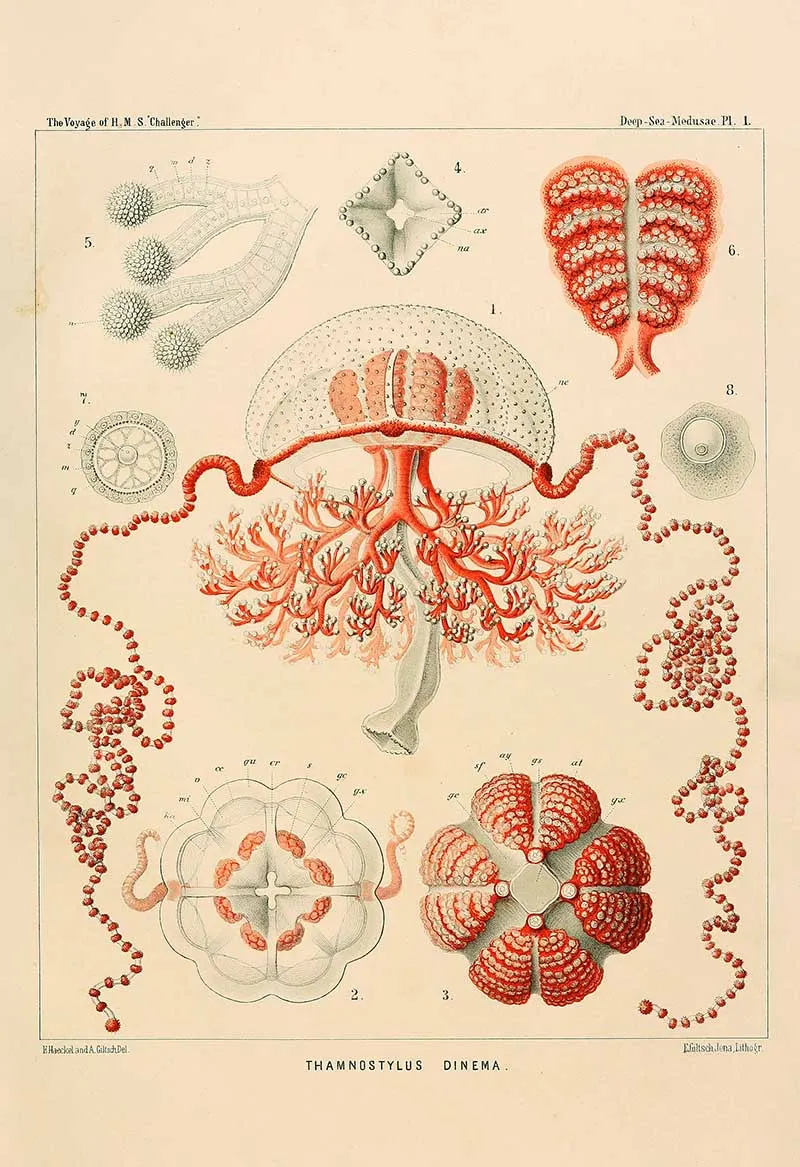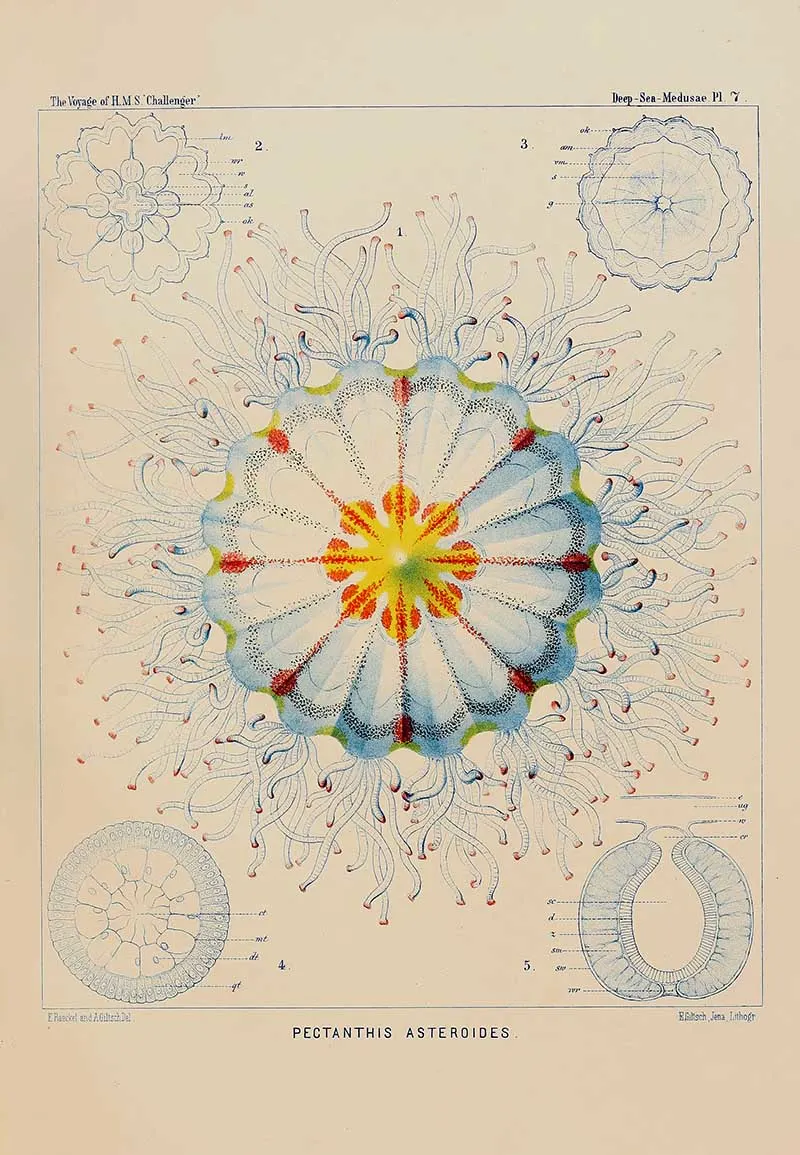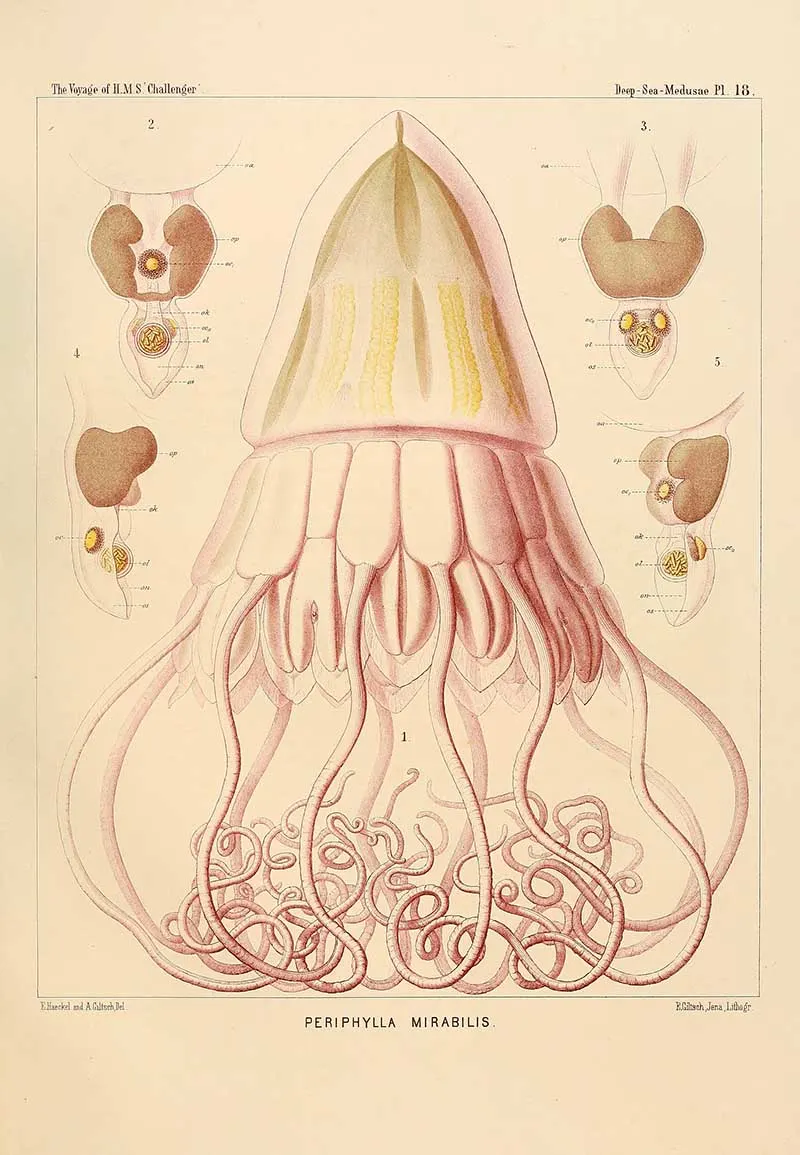Inside: A collection of free printable Ernst Haeckel jellyfish prints, all in the Public Domain.
At first thought, jellyfish prints may not sound very exciting. But don’t be fooled by the subject matter. I would argue that these beautiful Ernst Haeckel paintings belong in an art book as much as a Zoological encyclopedia.
Even Ernst Haeckel would agree with this as he built a house named Villa Medusa. He decorated the ceilings with frescoes of jellyfish that he had drawn for his scientific books.
There is already a collection of Ernst Haeckel illustrations of animals and sea creatures on the site from his famous book Kunstformen der Natur (“Art Forms of Nature”). This book influenced the Art Nouveau artistic movement (like Seguy’s insects).
Who Was Ernst Haeckel
Ernst Haeckel (1834 1919) was a German zoologist, naturalist, marine biologist and artist. He started with a doctorate in medicine but ended up as a professor of zoology at the University at Jena, where he worked for 47 years, from 1862 to 1909.
He was a prominent zoologist, a contemporary and an advocate of Charles Darwin. His contributions to science are enormous, and his legacy continues today.
Ernst discovered, described and named thousands of new species of animals, particularly jellyfish. He illustrated the world’s first encyclopedia of deep-sea jellyfish — a multi-part catalogue of more than six hundred medusa species.
Ernst was struck with tragedy when his beloved fiancee Anna Sethe died suddenly at the age of 29 years (burst appendix). The grief for him was overwhelming, and he took himself off to Nice in France to try and recover. Whilst there, he discovered a new and beautiful species of Medusa, which reminded him of Anna, and he named it after her Mitrocoma Annae.
A few years later, when a colleague found a new medusa species more beautiful than Mitrocoma Annae, Haeckel had to name it after his first wife. He called it Desmonema Annasethe.
Pin it for later
9 Fun Facts About Jellyfish
- Jellyfish are the world’s oldest multi-cell organism. They were here before dinosaurs, trees and even fungi.
- Unlike other sea creatures, they are bucking the trend by adapting well to climate change. They are thriving in the world’s oceans. That’s probably why they have been around for over 700 million years.
- They are found worldwide, from surface waters to the deep sea. Over 2000 species have formally been identified. But scientists believe there could be ups 300,000.
- Jellyfish are 98% water and have no bones or brain but an elementary nervous system with receptors that detect light, vibrations, and chemicals in the water.
- Some species are bioluminescent, which means they produce their own light.
- Most Jellyfish live for about a year, and some only live a few days. But one species, Turritopsis dohrnii, is considered immortal due to transdifferentiation.
- The smallest jellyfish are almost invisible at 0.5mm, and the largest species, Nomura’s jellyfish, can grow to 2 meters in diameter and weigh up to 200kg.
- Some species of jellyfish are the most venomous creatures on earth. A thumb-sized species of box jellyfish can kill an adult in a couple of minutes with one sting. And they have enough venom to kill 60 more humans.
How To Download Ernst Haeckel’s Jellyfish Prints
Click on the title above the jellyfish illustration you want to download. A higher-resolution image will open in a new window. Click on that image, and you can save or print it.
All the drawings below are in the Public Domain and copyright free.
Haeckel illustrated a lot of jellyfish in his lifetime. I can’t feature them all here, but I have chosen 25 I particularly like, my favourite being print 16 (Discomedusa Polybostricha) and 23 (Periphylla mirabilis).
If I come across any more jellyfish prints that are paricualarly beautiful, I’ll add them to this collection.
1879 Prints 1-18 From University of Jena
The following Ernst Haeckel Jellyfish drawings are from the 1879 “Memoranda of the Medical and Natural Science Society in Jena” from a copy held in the University of Harvard Library.
There are about 1,200 species of hydrozoans in the order Anthomedusa (Anthoathecata) worldwide.
Print 3: ANTHOMEDUSAE Margalis
Jellyfish of the genus is characterised by having the marginal tentacles of their medusae arranged in four bundles.
Print 5 ANTHOMEDUSAE Cladonematidae
Cladonematidae is a small family of anthomedusan hydrozoans. They have stolonal hydroid colonies, and their medusae are benthic and can crawl across the sediment; however, many species have lost the ability to swim.
Ernst Haeckel Jellyfish species in the order Leptomedusae.
Print 8 Leptomedusae MlTROCOMA
Plate 9 Leptomedusae OCTORCHIS
Print 10 Leptomedusae Aequoreidae -Blue
Aequoreidae is a family of hydrozoans, sometimes called the many-ribbed jellyfish. There are approximately 30 known species found in temperate and tropical marine coastal environments.
Narcomedusae jellyfish catch large, fast-moving prey with their tentacles. They hold their tentacles perpendicular to their swimming direction to cover a larger area. To eat their catch, they then bend the tentacles towards their mouths.
Stauromedusae is more commonly known as stalked Jellyfish. They have a trumpet-shaped body, oriented upside-down compared to other Jellyfish, with the tentacles projecting upwards and the stalk in the umbrella’s centre.
Print 13 – STAUROMEDUSAE Lucernaria
Periphyllidae are more commonly known as helmet jellyfish due to their shape.
Print 16 – Discomedusa Polybostricha
Plate 17 – Discomedusa Stomolophus
Stomolophus is a genus of true jellyfish from the West Atlantic and Pacific.
Print 18 Discomedusa Cannorhiza
Prints 19-25 Challenger Expedition
The following Ernst Haeckel Jellyfish prints are from “Monographie der Medusen“, published after the Challenger Expedition (1879). This book is also held at Harvard University Library.
The Challenger expedition of 1872–1876 was a pioneering scientific journey that made many discoveries to lay the foundation of oceanography—named after the naval vessel that undertook the trip, HMS Challenger.
Print 20 Pectanthis asteroides
Plate 21 Tesserantha connectens
Print 22 – Periphylla mirabilis
Print 23 Periphylla mirabilis 2
The illustration below is of the same species of jellyfish as the one above. Haeckel has just painted it from a different angle, the underside.
Print 24 Nauphanta challengeri
The name of this jellyfish species, suggests that Haeckel named it after the expedition ship Challenger.
Other Sealife Prints
Don’t forget to checkout the many other vintage sealife prints on the site.
For example, if you liked these jellyfish, you will probably like the popular vintage octopus collection or Louis Renard’s fish and Japanese fish woodblock prints.
Other beautiful oceanographic images include those of the Australian coral reef and Adolphe Millot’s sealife posters.
Ernst Haeckel painted other creatures besides jellyfish; for example, there is a vibrant illustration of Haeckel Hummingbirds here.
If you fancy, you can Buy Me A Coffee Here.

